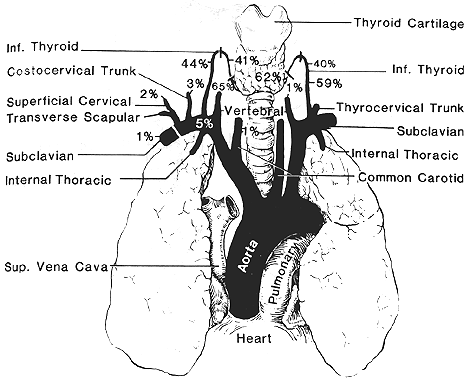

Illustrated Encyclopedia of Human Anatomic Variation: Opus II: Cardiovascular System
Ronald A. Bergman, PhD
Adel K. Afifi, MD, MS
Ryosuke Miyauchi, MD
Peer Review Status: Internally Peer Reviewed

The perpendicular lines that transect the inferior thyroid arteries divide the vessel into ascending, descending, and terminal segments. The number in percent either near or on a vessel indicates the instances in which esophageal rami originate from a part of a vessel or from a particular vessel.
Daseler and Anson also reported the results of detailed dissections made in 62 bodies (115 body-halves), concerning the arterial supply to the cervical and upper thororacic portions of the esophagus and trachea.
"The pharynx, esophagus, and trachea are usually supplied by several very fine arterial twigs from the terminal branches of the inferior thyroid arteries. Although these arterial branches are quite small in size, they are usually multiple in number, ranging from 1 to 4 on either side. These branches may pass directly to the esophagus and trachea, or may pursue a long and devious course downward into the superior mediastinum, before breaking up into their terminal branches. As a rule, this termninal branching occurs in the region of the groove formed between the trachea and esophagus, with the terminal twigs supplying the adjacent surfaces of both structures.
Single arterial branches were present 31 times on the right side and 27 times on the left. Dual arterial branches were found 18 times on the right and 21 times on the left. Triple arterial twigs were encountered on 15 sides, 8 on the right and 7 on the left, while quadruple branches were present on 3 left sides.
Since many of the dissections were performed by our freshman medical students, it is possible that multiple branches occur much more frequently than is indicated by this study.
The arterial branches to the esophagus and trachea were derived from the distal half of the inferior thyroid artery 63 times on the right and 65 times on the left side. The esophageal and tracheal arterial branches originated from the proximal half of the inferior thyroid artery 20 times on the right and 23 times on the left side. These arterial branches took origin from the thyrocervical trunk proper, before its division into terminal branches, in 10 cases, 4 on the right and 6 on the left side. In 2 cases, 1 on each side, these arterial branches were derived from the costocervical trunk, whereas in 2 additional cases, 1 on either side, the arterial branches took origin from the first part of the subclavian artery. In 1 specimen, on the right, the arterial twig to the esophagus and trachea arose as a branch of the innominate artery, while in another specimen, also on the right side, this vessel arose as a direct branch of the common carotid artery. On the left side of this specimen, this twig arose as a branch of the vertebral artery, the inferior thyroid artery being absent. In another specimen, in which the inferior thyroid artery was also absent, a large, short trunk dividing into 4 separate twigs, arose as a branch from the common trunk of a vessel from which the superficial and ascending cervical arteries and suprascapular artery took origin."
Redrawn from Anson, B.J. An Atlas of Human Anatomy W.B. Saunders Co., Philadelphia, 1950.
Section Top | Title Page
Please send us comments by filling out our Comment Form.
All contents copyright © 1995-2024 the Author(s) and Michael P. D'Alessandro, M.D. All rights reserved.
"Anatomy Atlases", the Anatomy Atlases logo, and "A digital library of anatomy information" are all Trademarks of Michael P. D'Alessandro, M.D.
Anatomy Atlases is funded in whole by Michael P. D'Alessandro, M.D. Advertising is not accepted.
Your personal information remains confidential and is not sold, leased, or given to any third party be they reliable or not.
The information contained in Anatomy Atlases is not a substitute for the medical care and advice of your physician. There may be variations in treatment that your physician may recommend based on individual facts and circumstances.
URL: http://www.anatomyatlases.org/